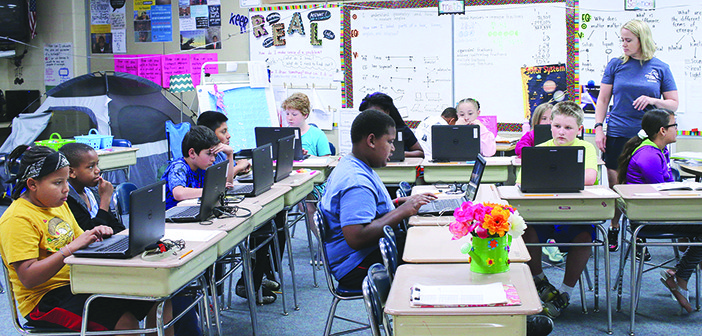
North Side fourth grader Anna Jefson says the ‘Prodigy’ game shown helps her improve her math skills.
By Jeff Keeling
Kaytee Dean and 10 of her fourth graders at North Side Elementary were in “Kahoots” Monday morning, and it involved a bunch of laptops, a projector screen and some triangles. Side effects include fun, excitement and the strengthening of math skills.
The students, along with their third and fourth-grade counterparts at North Side, are on the leading edge of the Johnson City Schools’ foray into “blended learning.” Last summer, the system hired David Timbs to be its first-ever supervisor of instructional technology, and in January, the North Side classes were among the first to go “one to one,” with each student being issued his or her own device.
Timbs said the time was right for more technology in the classroom for a couple of reasons.
“What we’re hearing from higher ed, what we’re hearing from the job market, is that we need students who are marketable and experienced in a variety of digital environments,” he said. “In addition, how students learn now has changed a great deal, even from when their parents were learning.
“This engages kids, and we’ve moved now from teachers sometimes being not just the purveyor of information to students, but being the facilitator of ferreting out what’s good information and what’s bad information, and what is really going to stick to help you learn.”
In Dean’s class, the new approach is getting rave reviews from students and teacher alike. Timbs said he and the administration used “backwards design” to get teacher buy-in and input. The system selected “Canvas” as its overall learning template, while different schools are and will be using different types of devices.

Rodrigo Luna, left, and Pedro Carlos-Hernandez work in Kaytee Dean’s fourth-grade class. Photos by Jeff Keeling
“I’m excited about that (using different devices), because we’re going to graduate students who are experienced on a variety of platforms, which is a big plus from what we’re hearing from business and industry,” Timbs said.
The Dell laptops North Side students are using seem to be working just fine. Dean said the Canvas template allows her to grade papers and interact with students from anywhere, and “it’s been awesome for them to do assignments and then upload their text.”
Whether students are striving to reach grade level or are working above grade level and hungry for more complex work, the devices and their accompanying software and online resources have opened a whole new world, Dean said.
“There are many different programs that really assess kids on their level and meet them on their level,” she said. In fact, a free program called “Front Row” assesses each child individually based on a pre-test, then uses algorithms to suggest to children which of their classmates would be appropriate for them to go to for collaborative help.
“It’s great, and everybody feels successful,” Dean said. As for some of her more advanced students, “they’ll come ask me, ‘hey, how do I do this math,’ which I haven’t done in a long time. Front Row will have shown them a video and then we’ll sit and problem solve. So now they’re getting challenged as well, and they love it.”
Oliver Johnson was among the students playing the Kahoots game. He said social studies is his favorite subject, and that having his own classroom device has been helpful. “Being able to do my homework on the laptop and search up stuff is a lot better than having to go to the tech lab or other places,” Johnson said.

North Side fourth grade teacher Kaytee Dean helps
students Korliea Daramie, left, and Aliyah Whitson.
Anna Jefson agreed. She had been playing “Prodigy,” a math game, before Johnson’s group came into Dean’s classroom.
“You’re a wizard,” Jefson said, pointing to her screen. “This is me. You go and do math. These are monsters right here, and you challenge them in math competitions.”
Jefson was also quick to point out that when it comes to research, one has to use discretion online. “Sometimes this has helped me learn better, but sometimes the Internet isn’t correct. You can’t always trust.”
Dean said all her students are more engaged and learning more effectively than they were prior to the introduction of the laptops – so much so that both they and she were actually looking forward to standardized testing, which the state cancelled this year due to issues with the online vendor.
“They were really disappointed for the most part,” said Dean, an 11-year classroom veteran who is in her sixth year at North Side. “They felt like they were ready, and I think there are so many programs out there that help them get there.”
Johnson City isn’t early to the one-to-one game, but Timbs – a veteran of more than two decades in teaching and administration with the last several years spent in technology – said the system is approaching the change the right way.
“My theory has been, you have to dive into the river at some point, but it’s very important that you stand on the bank and see what the people downstream have run into as far as successes and failures, and then you dive in,” Timbs said.




